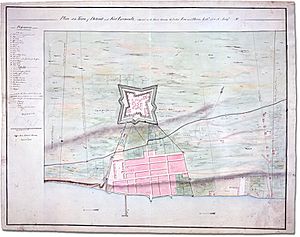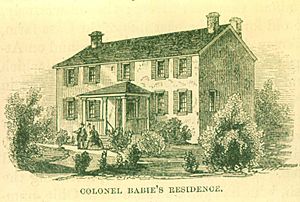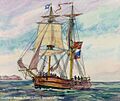Siege of Detroit facts for kids
Quick facts for kids Siege of Detroit |
|||||||
|---|---|---|---|---|---|---|---|
| Part of the War of 1812 | |||||||
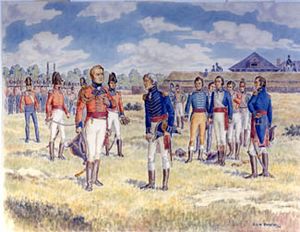 The Surrender of Detroit, by J.C.H. Forster |
|||||||
|
|||||||
| Belligerents | |||||||
Tecumseh's Confederacy |
|||||||
| Commanders and leaders | |||||||
Tecumseh |
|||||||
| Strength | |||||||
| 1,330 2 ships |
2,500 1 brig |
||||||
| Casualties and losses | |||||||
| 2 wounded | 7 killed 2,493 captured 1 brig captured |
||||||
The Siege of Detroit was an important event in the War of 1812. It's also known as the Surrender of Detroit. During this time, a British force led by Major General Isaac Brock, along with their Native American allies under Shawnee leader Tecumseh, used clever tricks to make U.S. Brigadier General William Hull give up the fort and town of Detroit, Michigan.
General Hull's army was actually larger than the British and Native American forces. But they were tired and losing hope. The British victory made the local Canadian soldiers and leaders feel much more confident. Many Native American groups in the Northwest Territory were also inspired to fight against U.S. settlements. The British held Detroit for over a year. However, they lost control after their small fleet was defeated on Lake Erie. This forced them to leave the western part of Canada.
Contents
Why Did the Siege of Detroit Happen?
American Plans and Preparations

In early 1812, there was growing tension between the United Kingdom and the United States. Michigan Territory Governor William Hull asked President James Madison to create an army. This army would protect the Northwest Territory from Native Americans. British agents were encouraging these Native Americans to fight against the United States.
It was very important to strengthen the outpost of Detroit. This town had about 800 people and only 120 soldiers. Some also suggested that this army could invade western Canada. Many recent immigrants from the United States lived there and might support the invasion.
President Madison and his Secretary of War agreed with this plan. They offered command of the army to Hull. He was an older soldier who had fought in the American Revolutionary War. Hull didn't want the job at first. But no other officer had his experience. He finally accepted and became a brigadier general.
His army included three groups of Ohio soldiers. Hull took command on May 25. He found that his soldiers were not well-equipped or disciplined. There were also no plans to supply them during their march. He quickly tried to fix these problems.
The army started marching north on June 10. They were joined by the 4th U.S. Infantry. Hull decided to take a new route to Detroit. This route went through a difficult swampy area in Ohio. On June 26, Hull received a letter saying that war was coming soon. He was told to hurry to Detroit.
His horses were tired from the hard march. So, he put supplies, medical items, and some sick men on a boat called the Cayahoga. This boat would travel across Lake Erie.
News of War and Capture of Supplies
The U.S. government had declared war on June 18. But the letter with this important news was sent by regular mail. It didn't reach Hull until July 2. However, the British ambassador in Washington sent the news quickly to Canada. British commanders immediately told all their outposts about the war.
On July 2, the Cayahoga boat was captured. It was taken by a Canadian ship near the British post at Amherstburg, Ontario. Hull reached Detroit on July 5. There, he was joined by more local soldiers.
The American army was low on supplies, especially food. The U.S. government urged Hull to attack Amherstburg. The fort there was defended by British soldiers, Native Americans, and local Canadian soldiers. Hull was not eager to attack. He wrote that "the British command the water and the savages."
Still, his army crossed into Canada on July 12. He issued messages trying to get Canadians to join his army. Some of his soldiers also raided areas along the Thames River. These actions made some local Canadian soldiers less willing to fight Hull. But few Canadians actively helped him.
There were some small fights with British outposts. Hull decided he couldn't attack the British fort without cannons. The cannon carriages were broken and needed fixing. So, he pulled his army back. Some of his officers disagreed with this retreat. They even talked about removing him from command. Hull felt his officers didn't support him.
British Actions and Tecumseh's Alliance
On July 17, a combined force of British soldiers, Canadian fur traders, and Native Americans captured Mackinac Island. This was an important trading post on Lake Huron. The American soldiers there didn't know that war had been declared.
Many Native Americans who helped capture Mackinac Island then moved south. They joined other groups at Amherstburg. News of the capture also made the Wyandots, who lived near Detroit, more hostile to the Americans. Hull learned about the capture of Mackinac on August 3. He worried that this would bring many more Native Americans against him. So, he left all the Canadian land his army had taken.
Hull's supply lines were long and open to attack. They ran along the Detroit River and Lake Erie. British ships controlled these waters. On August 4, a group led by Tecumseh attacked an American group. They captured more of Hull's messages. Hull sent a larger group to clear his supply lines. This group fought a British and Native American force on August 9. The British retreated, but then regrouped. Hull ordered his men to return to Detroit.

Meanwhile, British Major General Isaac Brock was in York (now Toronto). He was working to get Canadian soldiers ready for war. He had only a small number of regular soldiers. Brock knew that the American forces on the Niagara River were not a big threat yet. Hull's army was the only one threatening Canadian land.
In late July, Brock learned about the capture of Mackinac. He also heard that more British soldiers were coming to Canada. Brock sent 50 of his regular soldiers and 250 Canadian volunteers to Amherstburg. On August 5, he left York and followed them. He arrived at Amherstburg on August 13. At the same time, 200 more Native American warriors joined Tecumseh.
At Amherstburg, Brock learned from Hull's captured messages that the American army was losing hope. They feared the large number of Native Americans. They were also short on supplies. Brock quickly became friends with Tecumseh. This made sure the Native Americans would work with him. Brock later wrote that Tecumseh was a very wise and brave warrior.
Brock decided to attack Detroit right away. Most of his officers disagreed. The British had already tricked Hull. They made sure a fake letter fell into American hands. This letter asked that no more Native Americans come from Fort Mackinac. It claimed there were already 5,000 at Amherstburg and supplies were running out.
Brock sent Hull a demand to surrender. He warned that if the fighting started, the many Native Americans with his troops would be "beyond control." Brock's report said his attacking force included 600 warriors and 1300 soldiers, plus two warships.
The British used several tricks to make the Americans think they had more soldiers and Native Americans than they did. One idea was to have Canadian soldiers wear old British uniforms. This would make Hull think most of the British force were regular soldiers. The troops were told to light many small fires instead of a few large ones. This made it look like there was a much bigger army. They also marched in plain sight of the Americans, then quickly hid and marched again. This made it seem like endless lines of soldiers.
The Battle and Surrender
On August 15, British gunners set up cannons on the Canadian side of the Detroit River. They began firing on Fort Detroit. Two British ships also joined the attack.
In the early morning of August 16, Tecumseh's warriors crossed the river south of Detroit. Brock's soldiers followed them after sunrise. Brock's force was divided into three small groups.
Brock first planned to take a strong position and wait. He thought starvation and the bombing would force the Americans to surrender. But then he learned that Hull had sent 400 men to bring supplies to Detroit. This American group was only a few miles from the British rear. To avoid being attacked from two sides, Brock immediately moved forward to attack Fort Detroit. He aimed for the side farthest from the river, where the defenses were weakest.
Meanwhile, Tecumseh's warriors marched several times past an open area in the forest. The Americans could see them and heard their loud war cries. This made the Americans believe there were thousands of Native Americans.
As the British got ready to attack, a cannon shell exploded inside the fort. This caused injuries to American officers. Hull felt he couldn't hold out against such a large force. He was also low on gunpowder and ammunition. He believed surrendering would save his 2,500 soldiers and 700 civilians, including his own daughter, from a "massacre" by Native Americans.
Hull raised a white flag to surrender, even though his officers disagreed. He sent messages to Brock asking for three days to agree on terms. Brock replied that he would give him only three hours. Hull then surrendered his entire force. He reportedly said that the Native Americans were "numerous beyond example."
What Happened After the Siege?
British Success and Its Impact
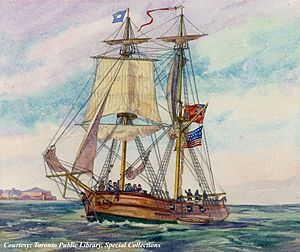
The British bombing killed seven Americans before the surrender. Two British gunners were wounded by American fire. After Hull surrendered, the 1,600 Ohio soldiers were allowed to go home. They were escorted south to protect them from Native American attacks. Most of the Michigan soldiers had already left. The 582 American regular soldiers were sent as prisoners to Quebec City.
The British captured many valuable items. These included 33 cannons, 300 rifles, 2,500 muskets, and the ship Adams. This was the only armed American ship on the Great Lakes. The British Navy used it. It was briefly recaptured two months later, but then destroyed by fire during a battle.
Hull's surrender was a big surprise to both sides. In the United States, many Native American groups started fighting American settlements. In Canada, the people and soldiers felt much more hopeful. Brock forgave the local soldiers who had been hesitant to fight. He rewarded those who had stayed at their posts. The 2,500 muskets captured from Hull were given to the Canadian soldiers who didn't have good equipment.
The British gained an important position in American territory. They controlled Michigan Territory and the Detroit area for most of the next year. Brock was seen as a hero. Tecumseh's influence over the Native American groups grew stronger. Brock then planned to attack New York State. But a ceasefire arranged by the Governor General of Canada stopped him. When the ceasefire ended, the Americans attacked in October. Brock was killed leading a counter-attack at the Battle of Queenston Heights.
American Response and Later Events
A third American invasion of Canada happened in November. The Americans accidentally fired on each other in the dark. They then retreated after a short fight. A Vermont newspaper wrote in January 1813 that the entire Canadian campaign had brought only "disaster, defeat, disgrace, and ruin and death."
General Hull was put on trial for his actions at Detroit. He was dismissed from the Army. This was in recognition of his good service in the American Revolution. American attempts to get Detroit back were difficult. This was due to poor communication and problems keeping soldiers in the field.
However, the Americans won a naval victory at the Battle of Lake Erie on September 10, 1813. This cut off supplies for the British at Amherstburg and Detroit. They were forced to retreat. Hull's replacement, Major General William Henry Harrison, chased the British and their Native American allies. He defeated them at the Battle of the Thames, where Tecumseh was killed.
Memorials and Legacy
The British 41st Regiment was honored with the battle name "Detroit." The captured flags of the 4th U.S. Infantry are now in a museum in Wales. A patriotic song called "The Bold Canadian" was written to celebrate the capture of Detroit. Seven Canadian Army regiments also carry the battle honor "Detroit." In 2012, the Royal Canadian Mint released a special coin showing Tecumseh to mark 200 years since the War of 1812.
On September 7, 2018, a bronze statue was unveiled in Windsor, Ontario. It shows Brock looking at Detroit through a telescope. Tecumseh is on horseback, watching the British cannons fire on the fort. The statue celebrates the teamwork between these two leaders that led to the capture of Detroit.
Images for kids
-
U.S. forces during the siege of Detroit were commanded by Brig. Gen. William Hull, an aging veteran of the American Revolutionary War.
-
Major General Isaac Brock met with Shawnee chief Tecumseh in Amherstburg, Ontario and quickly established a rapport, ensuring that he would cooperate with his movements.
-
USS Adams shortly after she was captured by British forces during the siege of Detroit
See also
 In Spanish: Sitio de Detroit para niños
In Spanish: Sitio de Detroit para niños


